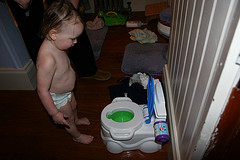
flickr.com/abbybatchelder
Behavioral modification, developed by B.F Skinner (1904-1990), is a psychological approach to treatment. Operant conditioning, which means “undesirable behaviors are replaced with more desirable ones through positive or negative reinforcement,” is the root of behavior modification. Positive reinforcement rewards specific behaviors. It is the more commonly used form of this treatment.
Behavior modification has been used as an effective way of treating bed wetting problems for both children and adults. It has also been effective in treating other problems like attention-deficit/hyperactivity disorder (ADHD), obsessive-compulsive disorder (OCD), phobias, separation anxiety disorder, and generalized anxiety disorder.
This form of treatment are safer and, in the long run, more effective than medical forms of treatment. You might have to be patient because it can take time before you see results.
Behavior modification aims to make the child learn to control his or her bladder. In this method, parents encourage and praise their child for waking up to a dry morning. Children tend to respond more constructively to this kind of positive reinforcement than they do to be punishment and reprimand for waking up to a wet bed. Always remember hat nocturnal enuresis is involuntary and not your child’s fault.
Remind your child every night to go to the bathroom before he or she goes to bed. Even if your child does not feel a big need to urinate, ask him or her to do so anyway to make sure you avoid any accidents at night.
You may also want to decrease your child’s liquid consumption at least two hours before its time for bed. Encourage your child to change his or her own sheets when they get wet. Just make sure your child does need feel like this is a punishment.
Retention control training is another form of behavior modification. This encourages the child to strengthen the bladder muscles. The process is gradual. It begins with delaying going to the bathroom for a few minutes and then for longer periods of time. Of, course this does not mean holding the urine in until it already hurts. The aim of this exercise is to “extend the capacity of the bladder and strengthen the muscle that holds back urination.” Do not perform retention control training on your child without your doctor’s permission.
Night-lifting is another behavior modification technique. In this method the parent sometimes wakes the child to ask if they have to pee. The parent would walk with the child to and from the bathroom. This aims to train the child to wake up when they have to go to the bathroom at night.
Tagged with: bedwetting • children bed wetting
Filed under: Bed Wetting